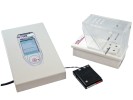Authors
L. Vaysse, J.C. Sol, Y. Lazorthes, M. Courtade-Saidi, M.J. Eaton et al.
Lab
Laboratory of Approches expérimentales et Thérapeutiques des Douleurs Neuropathiques, Toulouse, France.
Journal
Neuroscience Research
Abstract
Current understanding of chronic pain points a decrease in level of the inhibitory neurotransmitter GABA, in the spinal dorsal horn, leading to an imbalance between excitatory and inhibitory pathways. A subcloned derivative of the human NT2 cell line (hNT2.17) which, after neuronal differentiation, secretes different inhibitory neurotransmitters such as GABA and glycine has been recently isolated. In this study, we have investigated the effect of this new cell line on peripheral nerve injury induced by chronic constriction (CCI) and notably the effect on the cellular GABAergic pathway. Our data show that the decrease in GABA expression in the spinal dorsal horn of injured animals is concomitant with a decline of its synthetic enzyme GAD67-Ir and mRNA but not GAD65. Interestingly, in transplanted animals we observed a strong induction of GAD67 mRNA with one week after graft, which is followed by a recovery of GAD67 and GABA Ir. This effect paralleled a reduction of hindpaw hypersensitivity and thermal hyperalgesia induced by CCI. These results suggest that hNT2.17 GABA cells can modulate neuropathic pain after CCI certainly by minimizing the imbalance and restoring the cellular GABAergic pathway.
BIOSEB Instruments Used:
Static Weight Bearing Touch: Incapacitance Test (BIO-SWB-TOUCH-M)

 Pain - Thermal Allodynia / Hyperalgesia
Pain - Thermal Allodynia / Hyperalgesia Pain - Spontaneous Pain - Postural Deficit
Pain - Spontaneous Pain - Postural Deficit Pain - Mechanical Allodynia / Hyperalgesia
Pain - Mechanical Allodynia / Hyperalgesia Learning/Memory - Attention - Addiction
Learning/Memory - Attention - Addiction Physiology & Respiratory Research
Physiology & Respiratory Research
 Pain
Pain Central Nervous System (CNS)
Central Nervous System (CNS) Neurodegeneration
Neurodegeneration Sensory system
Sensory system Motor control
Motor control Mood Disorders
Mood Disorders Other disorders
Other disorders Muscular system
Muscular system Joints
Joints Metabolism
Metabolism Cross-disciplinary subjects
Cross-disciplinary subjects Preclinical studies and opioids: role in crisis management in the United States
Preclinical studies and opioids: role in crisis management in the United States 